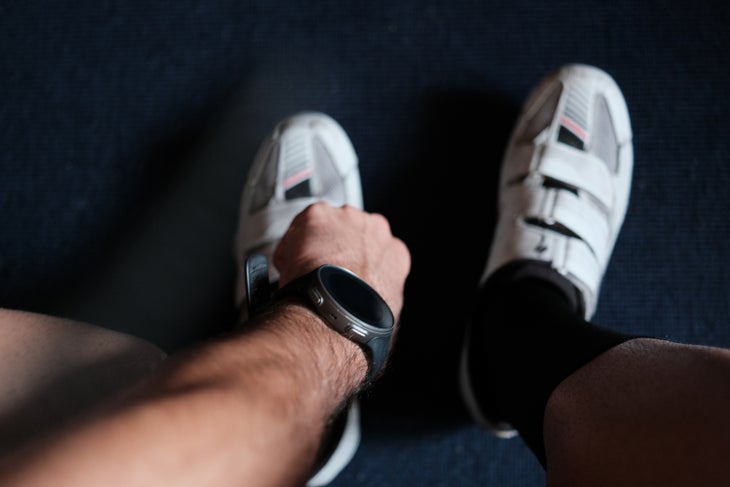New perk! Get after it with local recommendations just for you. Discover nearby events, routes out your door, and hidden gems when you sign up for the Local Running Drop.
Toe and/or foot numbness is a common problem among cyclists that often involves more than one root cause. In my experience with patients, I have found that numb toes while cycling stems from either one or a combination of these three sources:
3 Reasons for Numb Toes While Cycling
1. Poor Fitting Shoe
Our feet swell during cycling, due to increased blood supply demanded by muscle activity. Most often, athletes with toe numbness are wearing shoes that are too small, or are tightened too snugly at the beginning of the ride, which restricts blood supply to the nerves, thus causing the numbness. With the advances in cycling shoe construction and closure systems, it is easier than ever to find a shoe with multiple points of adjustment that accommodate variances in anatomy. Additionally, a prefabricated insole or custom orthotic can help with supporting the foot to maintain a stable position throughout the pedal stroke.
Finally, you probably need to lighten up! Unless you are a Tour de France rider and you are throwing down 1400+ watts for the last 200 meters (and if that sounds like a foreign language to you, then you definitely are not), you do not have to cinch down your shoes so tightly. Most shoes are made with high quality synthetic materials that are not meant to “break in” like your Penny Loafers from the 80’s.
I find that the simple act of making sure your closure system is appropriately tightened (read: not over tightened) will give the tissues in your foot the space it needs to work efficiently without compressing the nerves. Additionally, some gravel-specific shoes such as the Shimano RX8 provide a light and stiff shoe that has a little added flex. This flex allows for the needed foot mobility that helps with movement of blood and prevention of swelling.
Insoles also continue to evolve and more brands are adding metatarsal padding to help expand the space between your metatarsal heads (less squishing the nerves). Insoles such as SOLE (check out the Performance Thin with Met Pad), Specialized Body Geometry, and Solestar are all great options.

2. Poor Bike Fit
The aggressive time trial riding position for triathletes can increase the stress on the lower back and pelvis. Physiological limitations such as muscle tightness, strength imbalances, leg length discrepancy, or even a Morton’s neuroma (enlarged nerves between the metatarsal bones in the foot) can all lead to strain on the nerves that exit the back, eventually leading to numb toes while cycling. Ensure that your hamstrings and hip rotators are flexible and that your core is strong and stable. Consistency with exercise off the bike also pays dividends in peak performance and comfort on the bike. I firmly believe in getting a proper bike fit with physiological testing, regardless of complaints of toe numbness.
A good bike fit will play to your strengths and accommodate your weaknesses – which for triathletes usually is inflexibility. There are multiple stretches with excellent diagrams and instructions in The Triathlete Guide to Sprint and Olympic Triathlon Racing. In addition, some great products to help with improving tissue and joint mobility are the Rollga and Roll R3 foot roller.
3. Poor Cleat Positioning
Poor cleat position tends to be the most common issue I see leading to numb toes while cycling. Ideally, the center of the cleat (where the pedal spindle interfaces with the cleat) should be positioned just behind the ball of the foot for most comfort (some will recommend as much as 5mm). Too often, a forward cleat, coupled with a “mashing” pedal style often seen in triathletes and time trial specialists, increases the pressure under the ball of the foot where the nerves are most susceptible to being compressed. Check your cleat position (or better yet, get a bike fit with cleat adjustment) and make sure you are not feeling pressure when you apply force through the pedal.
Most companies in the industry have adopted the understanding that comfort equals speed. It is not always stiffer and more aero that gets you to the finish line faster (or happier for that matter). Long gone are the days of minimal adjustment cleat systems. Take advantage of the system and move those cleats back! The ankle is a triplanar joint (uses all three planes of motion). In moving the cleat back, you are stabilizing your foot to pedal interface by reducing the frontal and transverse planes of motion. Less accessory motion means less wasted motion while riding—fewer wasted watts and less accessory muscle activity which leads to earlier onset fatigue.
Remember, keeping those small muscles in the foot strong keeps your arch from collapsing—which helps prevent nerve compression on the bike and a myriad of problems during the run. You can pick up marbles with your toes or a great gadget for arch strengthening is the Elgin archxerciser.
Casey Maguire is a Los Angeles-based orthopedic physical therapist who has treated professional triathletes, cyclists, and multiple athletes in the NBA, NHL, NFL, and USTA. His focus is on functional biomechanics.